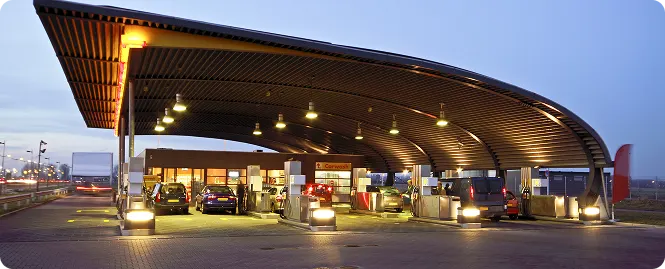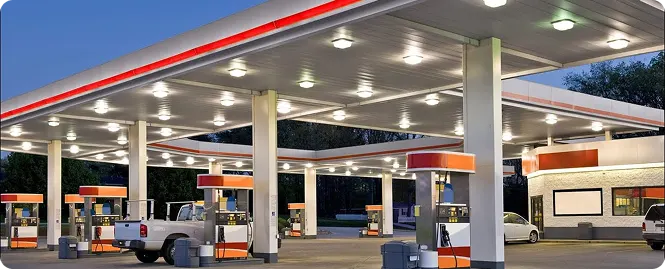How Much Does It Cost to Open a Gas Station?
Table of Contents
Key Takeaways
-
Opening a gas station requires a high upfront cost, including land, construction, fuel tanks, and gas pumps. Additional expenses come from franchise fees, business licenses, and regulatory compliance.
-
Gas station owners must obtain multiple permits and licenses to ensure environmental and safety compliance. These requirements can vary by state and impact overall startup costs.
-
Beyond fuel tanks and pumps, a gas station requires retail inventory, car washes, and convenience store equipment. Fuel supply contracts also influence profit margins and ongoing operational expenses.
-
Running a gas station involves labor costs, marketing, and fluctuating fuel prices. Market volatility and competition from alternative energy sources add further risks.
-
Securing funding through loans or investors is common. A strong business plan and diversified income streams, like car washes and convenience stores, help improve financial stability and growth.
The gas station industry remains a lucrative business that offers steady demand as consumers rely on fuel for daily transportation. Gas station owners can generate substantial profit margins with the right location, strategic pricing, and additional services like car washes or convenience stores. However, success depends on market conditions, fuel price fluctuations, and competition. Those who carefully plan their business model and optimize operational efficiency can turn their gas station into a highly profitable venture.
Opening a gas station can involve significant startup costs, ranging from land acquisition and construction to fuel tanks, gas pumps, and licensing fees. Additionally, franchise fees, operational expenses, and ongoing maintenance contribute to overall investment requirements. Understanding these financial factors can help potential owners plan effectively, secure funding, and manage risks. A strategic and well-crafted business plan is vital in order to effectively manage costs and secure long-term profitability in today’s competitive market.
Initial Costs and Setup
Purchasing or leasing land can be one of the most significant expenses when opening a gas station. Prime locations with high traffic may cost more but offer better profit potential. Prices can vary based on city, zoning laws, and accessibility. Leasing can reduce upfront costs, but ownership provides long-term financial benefits.
Building a gas station involves major construction costs, including fuel tanks, gas pumps, and convenience store space. Renovating an existing station may be cheaper, but upgrading equipment and ensuring regulatory compliance still add up. Additional expenses include canopies, signage, lighting, and safety systems, all crucial for a fully operational station.
Licensing, Permits, and Regulatory Costs
Operating a gas station typically requires multiple licenses and permits, including a business license, fuel dispensing permit, and fire safety certification. Depending on the location, additional approvals may be needed for selling alcohol, tobacco, or lottery tickets. Securing these permits involves fees, inspections, and regulatory approvals, which impact startup costs.
Strict environmental laws govern fuel storage, leakage prevention, and hazardous waste disposal. To comply with EPA and local regulations, owners must invest in double-walled fuel tanks, vapor recovery systems, and spill containment measures. Non-compliance can lead to hefty fines, making it essential to factor in environmental safety measures when planning costs.
Equipment and Infrastructure
Setting up a gas station requires fuel tanks, dispensers, and pumps, costing hundreds of thousands of dollars. Underground storage tanks must meet safety and environmental regulations, adding to the initial investment. High-quality equipment ensures efficient fuel flow, lowers maintenance costs, and provides long-term durability, making it an essential investment.
A reliable point-of-sale (POS) system is essential for managing fuel sales, convenience store transactions, and customer payments. Security investments like surveillance cameras, alarm systems, and proper lighting prevent theft and fraud. Additional infrastructure costs include signage, parking spaces, restrooms, and accessibility features, all necessary for smooth operations and customer satisfaction.
Inventory and Fuel Supply
Purchasing gasoline, diesel, and lubricants requires a significant upfront investment. Fuel prices usually fluctuate based on market conditions, location, and supplier agreements, directly affecting startup costs. Additionally, stocking a convenience store with snacks, beverages, and auto supplies may add a little to the initial expenses, but they eventually boost overall profitability.
Partnering with reliable fuel suppliers helps maintain a steady supply of resources. Contracts may include bulk purchasing discounts, delivery schedules, and brand partnerships. Efficient inventory management helps prevent shortages and overstocking, ensuring consistent revenue flow. Tracking fuel levels and adjusting orders based on consumer demand and seasonal trends is crucial for profitability.
Staffing and Labor Costs
A gas station relies on cashiers, managers, and maintenance staff to keep operations running smoothly. Cashiers handle transactions and customer service, while managers oversee inventory, scheduling, and compliance. Maintenance staff ensures the station remains safe and functional. The number of employees varies based on location, business size, and operating hours.
Staff wages, overtime, and benefits make up a significant portion of operational costs. Competitive salaries help attract and retain skilled employees while providing the employees with training in safety procedures, fuel handling, and customer service to ensure efficiency. Well-trained employees reduce risks, enhance customer experience, and contribute to long-term business success.
Marketing and Branding
Strong branding helps a gas station stand out. The costs for this can include logo design, signage, and promotional materials to create a recognizable identity. Investing in storefront aesthetics, fuel pump advertising, and loyalty programs enhances visibility. A well-branded station builds trust, encourages repeat business, and differentiates itself from competitors.
Through billboards, flyers, and digital ads, marketing efforts can focus on local reach. Social media promotions, discounts, and partnerships with nearby businesses can drive foot traffic. Offering rewards programs and fuel discounts encourages customer loyalty. A well-planned advertising strategy boosts visibility and increases sales, making the station a go-to stop.
Ongoing Operating Expenses
Running a gas station comes with ongoing expenses like electricity for fuel pumps, water usage, and heating or cooling systems. Insurance costs add another layer of cost, covering liability, property damage, and environmental risks. Routine maintenance for pumps, POS systems, and security cameras ensures smooth operations and prevents costly breakdowns.
Beyond fuel, convenience stores require regular restocking of snacks, beverages, and automotive supplies. Costs may also include cleaning supplies, restroom maintenance, and technology upgrades. Keeping a well-managed inventory prevents shortages and maximizes profits. Other ongoing expenses like franchise fees, licensing renewals, and staff uniforms contribute to the station’s long-term success.
Financing and Funding Options
Starting a gas station requires significant capital, but several funding options can help. Business loans from banks, private investors, and government grants provide financial support. Some entrepreneurs opt for franchise partnerships to reduce upfront costs. Understanding these options helps gas station owners secure the necessary capital without financial strain.
A solid business plan is crucial for securing funding to cover land acquisition, construction, equipment, and inventory. Lenders and investors look for detailed financial projections and risk assessments. Seeking SBA loans, industry-specific grants, or fuel supplier financing can help manage initial expenses while ensuring smooth day-to-day operations and long-term stability.
Challenges and Risks of Opening a Gas Station
Opening a gas station involves navigating hurdles and uncertainties. From securing funding to managing fuel price fluctuations and staying competitive, here are some challenges that impact long-term success and profitability:
High Initial Investment and Setup Costs
Opening a gas station isn’t just about fuel; it’s about hefty upfront expenses. The costs can add up quickly between purchasing land, installing tanks and pumps, securing permits, and setting up a convenience store. Without proper financial planning, the dream of owning a station can stall before it even starts.
Fluctuating Fuel Prices and Market Volatility
Fuel prices are like roller coasters—exciting for consumers when they drop but nerve-wracking for business owners. External factors like global oil supply, political instability, and market demand impact pricing. Staying profitable means adapting to price swings while keeping customers happy, which requires smart pricing strategies and diversified revenue streams.
Environmental and Regulatory Compliance
Running a gas station comes with some serious environmental responsibilities. From preventing fuel leaks to meeting strict government regulations, compliance is non-negotiable. Failing to follow environmental laws can lead to hefty fines or even shutdowns. Investing in eco-friendly practices and proper fuel storage isn’t just bright—it’s essential for long-term sustainability.
Competition from Other Gas Stations and Alternative Energy
It’s not just the station across the street you have to worry about—electric vehicle charging stations and alternative fuels are now changing the game, and staying competitive means offering more than just gas. Convenience store upgrades, loyalty programs, and additional services like car washes can help attract and retain customers.
Dependence on Consumer Traffic and Economic Factors
A gas station’s success depends on steady customer traffic, but economic downturns and shifts in travel habits can also heavily impact sales. Location can mean everything, but so is adapting to the ever-changing consumer needs. Adding high-demand items, expanding services, and engaging in local marketing can help drive consistent business.
Conclusion
Starting a gas station calls for carefully thought-out planning and significant investment. From purchasing land and securing permits to installing fuel pumps and stocking inventory, each step comes with costs. Operational expenses, staffing, and marketing add to the financial burden, making it crucial to have a well-structured business plan.
Success starts with smart budgeting and strategic planning. Estimating startup costs, exploring funding options like business loans or investors, and setting aside reserves for unexpected expenses keep operations smooth. A detailed business plan and strong financial backing will help navigate industry challenges and set the station up for long-term profitability.
Gas stations that also have convenience stores face multiple risks, from theft and property damage to liability claims. Having the right insurance coverage protects against financial losses and legal issues. Policies covering general liability, workers' compensation, and business interruption ensure that the business remains financially secure even in unexpected situations.









